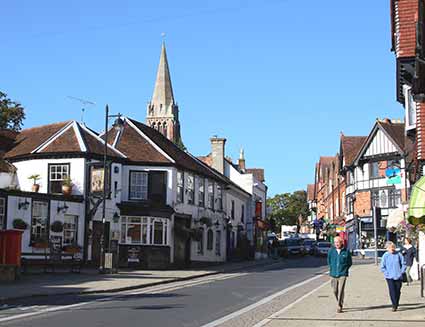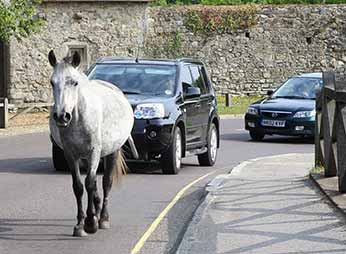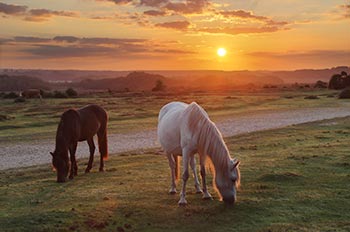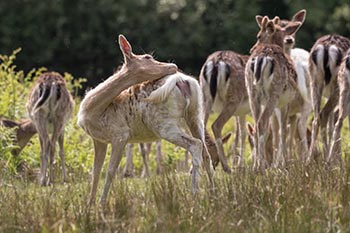New Forest villages - an introduction

New Forest Villages offer all the facilities expected of popular visitor destinations. Pubs serve real ale and real hospitality. English, French, Indian, Chinese and Thai restaurants offer a wide choice of food, whilst hotels, guest houses and bed and breakfast establishments cater for every level of accommodation need.
New Forest Villages also boast a wide range of shops and all the other trappings of modern life, but for residents and visitors alike, there's far more than that to see and enjoy. Where else, for example, do ponies, donkeys and sometimes cattle wander freely along village streets, at times holding up the traffic but always causing amusement amongst on-lookers?
Lyndhurst (A), for example, is the most centrally located New Forest village. Sometimes known as the Capital of the New Forest, it is home to the ancient Verderers' Hall and to Queen's House, an essentially 17th century building on the site of a 13th century Royal manor house, and now the local Forestry Commission headquarters.
Nearby Brockenhurst (B) is of equal interest - it is the only New Forest Village that had a church mentioned in the Domesday Book. The village, though, has grown substantially since those times, and has, in fact, shifted its centre away from church and manor to be closer to the through road and mainline railway station.
Beaulieu (C) is perhaps best known for the National Motor Museum and its old Cistercian Abbey, although the village's picturesque location alongside a tidal mill-pond is equally noteworthy, and so is its long-established connection with the old ship building centre at nearby Buckler's Hard.
Burley (D), meanwhile, like other New Forest Villages, offers direct access to the open lands of the New Forest, has a pub connected by local legend to the once prolific smuggling trade and once had a resident who was a renowned White Witch!
And finally, there is Sway (E), 4.5 kilometres (2¾ miles) south-west of Brockenhurst. A small(ish) village just outside the old New Forest perambulation, yet within the New Forest National Park, Sway is perhaps best known for the Sway Tower, often referred to as Peterson’s Folly, a 66 metre (200 feet) high concrete tower constructed in the late 19th century. Sway, like Brockenhurst, has a railway station on the Weymouth / Bournemouth / Southampton / London Waterloo main line, and a number of shops, pubs, restaurants, hotels and numerous residential properties.

Then, of course, there are many other less substantial settlements within the New Forest National Park, relatively small, often well-spread hamlets with long, fascinating histories of habitation that today may or may not have a village hall, shop, church and chapel; but often possess always hospitable New Forest country pubs – examples of local hamlets include Boldre, Bramshaw, Brook, East Boldre, Exbury, Fritham, Frogham, Godshill, Hale, Linwood and Woodgreen.
Enjoy discovering these and other New Forest Villages within the pages of the New Forest Explorers’ Guide, for here village life and history are graphically brought together in words and pictures.
Old prints, postcards and maps are used to depict the New Forest Villages as they were in days gone-by, and walk routes are included that take the traveller past many of the features mentioned.
Travel slowly, then, and preferably on foot. Absorb the unique atmosphere of these places, and experience the spirit of life as it was in earlier times.
Find out more about New Forest villages
More links
Search this site


Sika deer continue to engage in rutting behaviour, and will do so until December.
Pigs seek out the remains of the acorn crop.
Beech leaves are transformed into a magnificent mosaic of glorious reds and golds. Other deciduous trees, too, take on an autumnal cloak before their leaves fall.
Dragonflies can occasionally be seen on the wing on bright days early in the month.
December
Foxglove leaves survive the winter at ground level, and offer the prospect of colourful summer blooms to come.
Redwings and fieldfares, autumn and winter visitors, gorge on haws and holly berries.
Great grey shrikes and hen harriers hunt over the heaths and other open spaces.
Honeysuckle by the end of the month often shows welcome signs of new growth.

Sadly, 58 animals were killed - 35 ponies, 13 cows, 8 donkeys and 2 sheep, whilst a further 32 were injured - 3 pigs, 9 donkeys, 11 cows and 9 ponies.
(Forty-three accidents occurred in daylight, 15 at twilight and 101 in the dark. Twenty-seven accidents were not reported by the driver involved).
Here's just one horrific example - Three donkeys killed in collision with van at notorious New Forest blackspot (Advertiser and Times)

